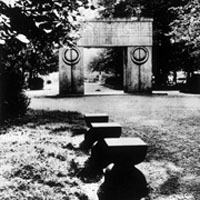
Avenue of Heroes by Brancusi
The International Carlo Scarpa Prize for Gardens
V Annual Award, 1994
The masterpiece of landscaping and sculpture that Constantin Brancusi left at Târgu Jiu (1937-1938), not far from the village of Hobita where he was born in Romania, is one of the supreme gestures of contemporary art. The site marks the spot where the Romanian people stopped the advancing invasion of their country in 1916.
The work comprises three parts: the Table of silence, the Door of the embrace, and the Endless column. They lie along a 1.7 kilometre-long line that passes through the city, starting from the River Jiu and in line with the Orthodox Church of Saints Peter and Paul, a mediating point in the journey along the Avenue of Heroes to the rising section at the end, which establishes a direct dialogue, a sacred link, with the great open spaces of the Carpathian landscape.
After decades of indifference, the award of the 1994 Carlo Scarpa Prize signals an urgent call for the mobilization of intellectual energy and material investment on an international scale in order to launch a programme of recovery and protection/promotion of the site (river, park and monuments). Romanian art has occupied a universally acknowledged place from the age of wooden buildings, since the monastic architecture and painting cycles of Bucovina and Oltenia dating from both mediaeval and humanistic times and on to the great scholars and artists that have come from Romania in our own age, from Lucien Blaga and Constantin Noica to Mircea Eliade and Emile Cioran from George Enescu to Tudor Arghezi and Nichita Stanescu.
The Jury invited Prof. Barbu Brezianu to the award ceremony to give direct personal testimony of his seminal studies of Brancusi, and government minister Marin Sorescu to receive the prize.
1994 Carlo Scarpa Prize Statement, edited by the Jury.
